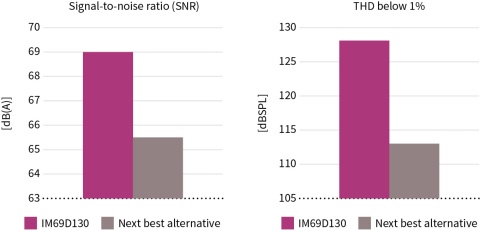Expand the boundaries of audio experience with XENSIV™ MEMS microphones: achieve 69dB SNR
You are designing a voice-controlled application for your next generation of audio products? For a voice system to work well, good raw data from the microphone must be fed to the voice processing algorithms running on the main system. Infineon’s XENSIVTM IM69D130 MEMS microphone provides the best input for algorithms and high speech intelligibility. For you, we and our voice-user interface ecosystem partners are leveraging our technological expertise, we provide innovative reference platforms and ready-to-use next-generation voice-user interface solutions for faster go-to-market.
Infineon high-performance MEMS microphones for your application
The XENSIV™ MEMS microphone is designed for applications where a low self-noise (high SNR), wide dynamic range, low distortion, and a high acoustic overload point are required. The Dual Backplate MEMS technology is based on a miniaturized symmetrical microphone design, similar to studio condenser microphones, and results in high linearity of the output signal within a dynamic range of 105 dB. The microphone distortion does not exceed 1 percent even at sound pressure levels of 128 dB SPL. The flat frequency response (28 Hz low-frequency roll-off) and tight manufacturing tolerance result in close phase matching of the microphones, which is important for multi-microphone (array) applications. The digital microphone ASIC contains an extremely low-noise preamplifier and a high-performance sigma-delta ADC. Different power modes can be selected, to suit specific current consumption requirements. Each IM69D130 MEMS microphone is trimmed with an advanced Infineon calibration algorithm, resulting in small sensitivity tolerances (±1 dB). The phase response is tightly matched (± 2°) between microphones, to support beamforming applications.
Infineon XENSIV™ MEMS microphone guarantees your application also high fidelity and far-field audio recording with crystal clear quality as well as an ultra-low group delay for latency-critical applications.
Key features

- 69 dB(A) signal-to-noise ratio
- Below 1 percent distortion at 128 dBSPL (130 dBSPL AOP)
- Digital (PDM) interface with 6 µs group delay at 1 kHz
- Tight sensitivity (-36 ±1 dB) and phase (±2°) tolerances
- 28 Hz low-frequency roll-off
- 980 µA current consumption (300 µA in low-power mode)

